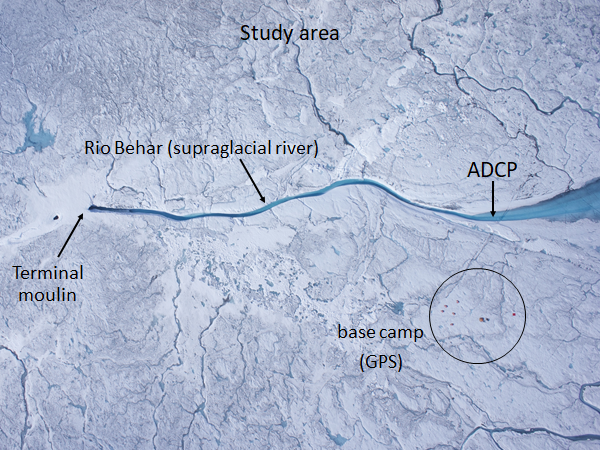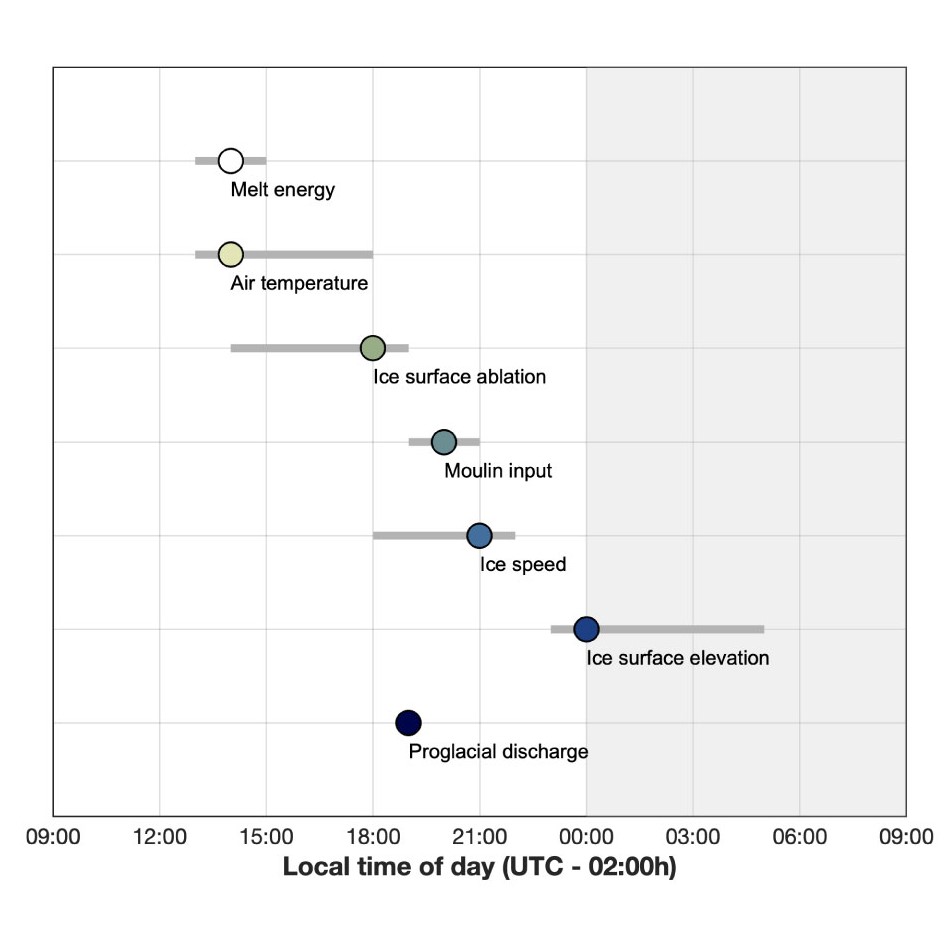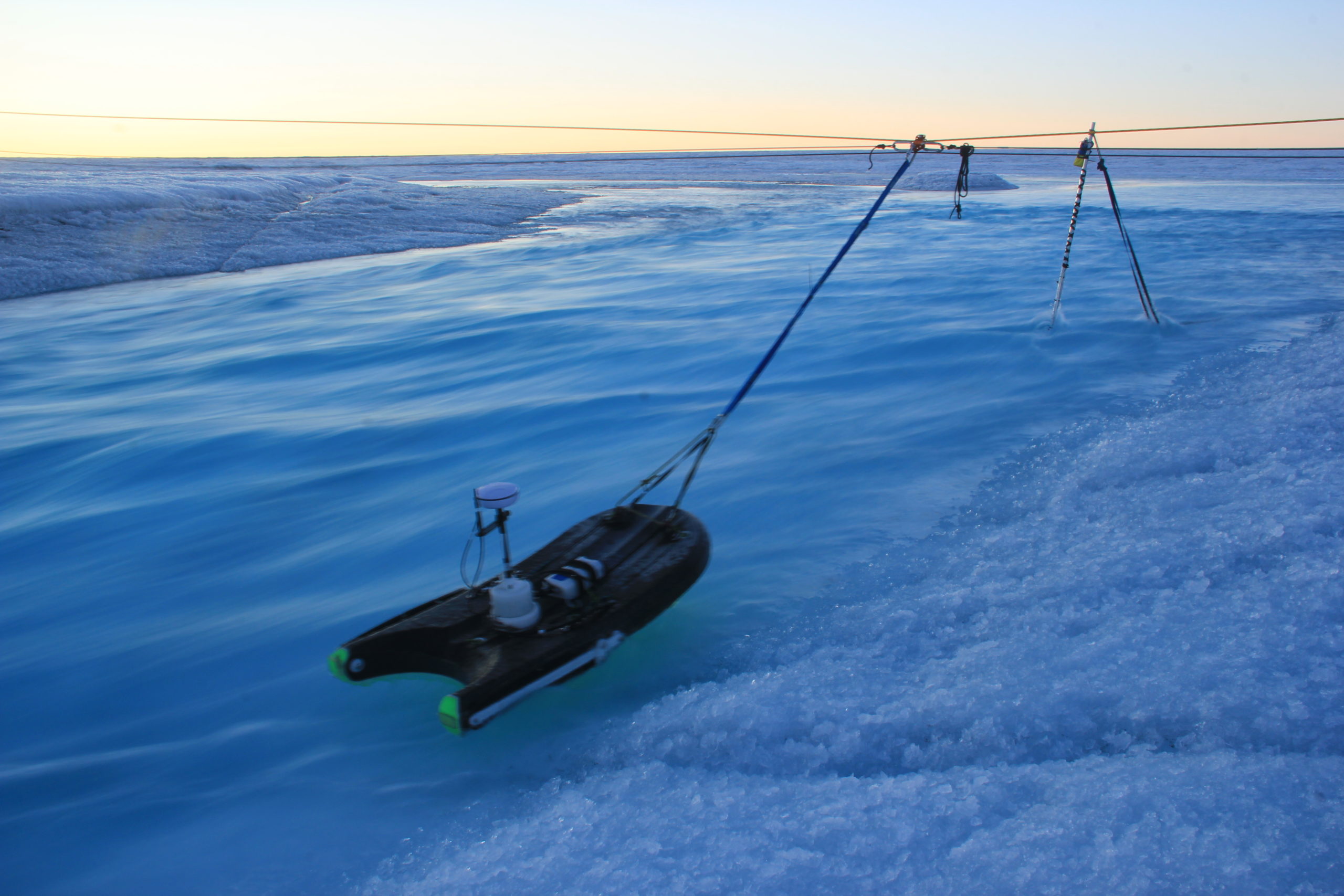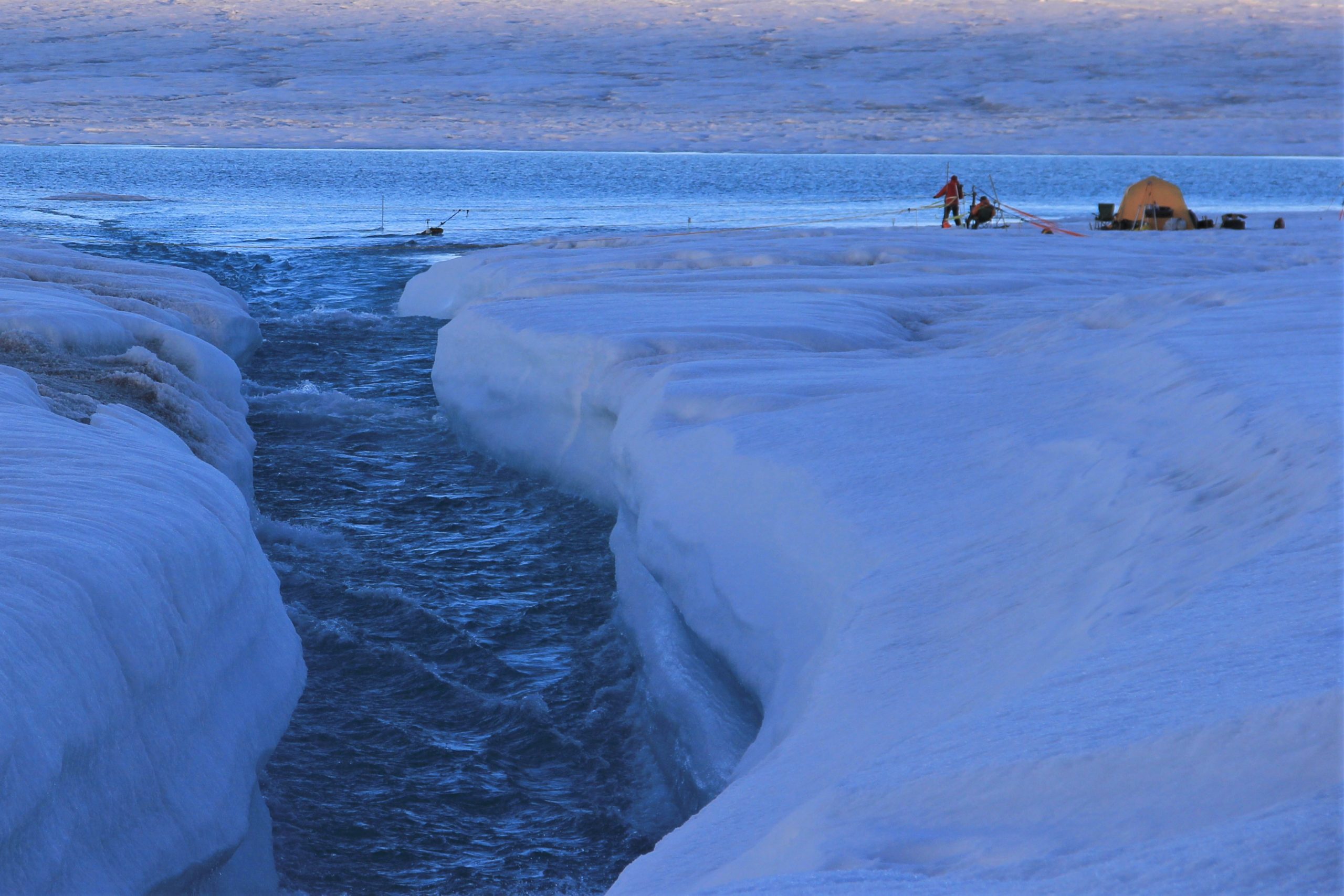The slide of the Greenland ice sheet surges in daily cycles in a delayed response to the Sun warming its surface. Meltwater drains below the ice and is temporarily trapped under its belly, lubricating its flow to the sea, according to a new study.
The new research is the first report of direct observations from a field campaign showing how daily changes in the volume of water under the ice can drive the flow velocities of a glacier. It was published today in Geophysical Research Letters, AGU's journal for high-impact, short-format reports with immediate implications spanning all Earth and space sciences.
The findings contradict a long-held view about ice sliding velocities and water stored under a glacier known as the steady-state basal sliding law, which scientists have used to predict how fast ice sheets will slide based on the total volume of water underneath the ice.

Drone's eye view of the study site in the ablation zone, or area of active melting, of the Russell Glacier near Kangerlussuaq, Greenland.
Credit: Northern Change Research Laboratory, Brown University
The new study tracked the volume of water pouring into a hole in the Russell Glacier near Kangerlussuaq, Greenland, called a moulin, from a river on top of the ice named Rio Behar, which catches meltwater from about 60 square kilometers of ice on the southwest Greenland ice sheet. Moulins drain water from the surface to the underside of the ice.
By measuring the amount of meltwater pouring into the moulin and the amount exiting the glacier's edge, the researchers could calculate how much water was stored under the ice and how that volume changed. GPS measurements allowed the team to track how fast the ice sheet moves. They found a consistent daily pattern in the timing of ice melt and ice motion, strongly suggesting meltwater leads to short-term daily accelerations in the downhill slide of the ice.

Circadian rhythm of a glacier: Melt energy and air temperature peak near solar noon, followed by peaks in ice melting and evaporation, water discharge from the nose of the glacier, meltwater input to the moulin, speed of ice movement, and ice surface uplift. This figure presents only the timing of daily peaks, not subglacial routing delays and/or storages of meltwater. Circles show mean daily peak timing and bars show timing range of observations from the new study.
Credit: Geophysical Research Letters/AGU
The peak speed of the ice trailed the peak volume of water flowing into the moulin by a few hours and followed the peak melt energy delivered by sunlight, around local noon, by about 9 hours. Ice speed correlated strongly with melt energy, the amount of meltwater disappearing into the moulin, and the volume of water flowing out from under the front of the glacier.
Nightly peaks in the amount of water trapped under the glacier likely drive this surge, according to the authors.
Glacier slip n slide
When meltwater reaches the ice sheet's underlying bed, it can make the ice detach slightly and flow more rapidly. Because climate change leads to an increased amount of meltwater on the surface of the Greenland ice sheet, understanding the lubricating effects of that water as it reaches the bottom of the ice has become increasingly important.
The icesheet in Greenland's southwest has experienced rapid ice melt and retreat in recent decades.

Drone view of a meltwater lake, Russell Glacier, Greenland. Tiny dots in the upper left corner are the tents of the research team.
Credit: Northern Change Research Laboratory, Brown University
Glaciers that slide faster can eventually lead to the ice sheet melting a bit quicker than expected, and to increasing the amount of ice calved into the ocean. With a vast surface area roughly the size of Mexico, the Greenland Ice Sheet is the largest contributor to global sea level rise.
In the new study, the authors concluded the important factor influencing the speed of a sliding glacier in southwest Greenland was how quickly water pressure changed within cavities at the bed of the ice.
"Even if the cavities are small, as long as the pressure is ramping up very fast, they will make the ice slide faster," said Laurence C. Smith, a climate scientist at Brown University in Providence, Rhode Island, and lead author of the new study.
Lauren Andrews, a glaciologist at NASA's Goddard Space Flight Center in Greenbelt, Maryland, and an author of the new study likes to explain the interactions between surface meltwater, basal ice, and the bedrock, as tires that slide very rapidly on a wet road because of hydroplaning.

Researchers sample water volume on the Rio Behar, a river of meltwater on top of the Russell glacier on the southwest fringe of the Greenland ice sheet before it empties down the pipe of its terminal moulin.
Credit: Northern Change Research Laboratory, Brown University
"If you have a rapid perturbation of water going into the subglacial system, you overwhelm the system, and so you create essentially a layer of water at the interface that's not contained in channels or cavities anymore," Andrews said.
It's not the actual volume in water that drives ice velocity, Andrews explained, but the speed with which it builds up at a bedrock ice interface. For slow increases in water, the subglacial system has time to evolve to accommodate the same amount of water.
In recent years, other researchers have used similar methods to gauge the importance of the pressurization of water for ice sliding speeds in small alpine glaciers. Still, the lack of data directly from the ground has made it difficult for scientists to probe the interactions that speed up glaciers in Greenland.

The research team collects data at the edge of a meltwater lake on Russell Glacier, Greenland. Rio Behar rushes away into the foreground.
Credit: Northern Change Research Laboratory, Brown University
One of the trickiest aspects preventing scientists from fully understanding Greenland's ice sliding dynamics is the need to pair measurements of the flow of meltwater into a glacier with observations of the motion of the ice at the surface. On the Greenland Ice Sheet, especially the edge areas where ice is melting by the hour, the terrain is treacherous. That's why data from Smith's 2016 expedition is crucial for further studies of ice velocities.
"There's not a direct one-to-one relationship between the melting on the top and the meltwater exiting the ice sheet because the water is going through goodness knows what down below," Smith said.
Smith hopes the new findings can improve current climate models to predict the pace of future sea level rise from Greenland's ice in the face of climate change.
"The only tools that we have to predict the future are models," Smith said. "We have remote sensing, and we have field campaigns, so if we can use both to improve our modeling capability, we'll be better able to adapt and mitigate sea level rise and climate change."






